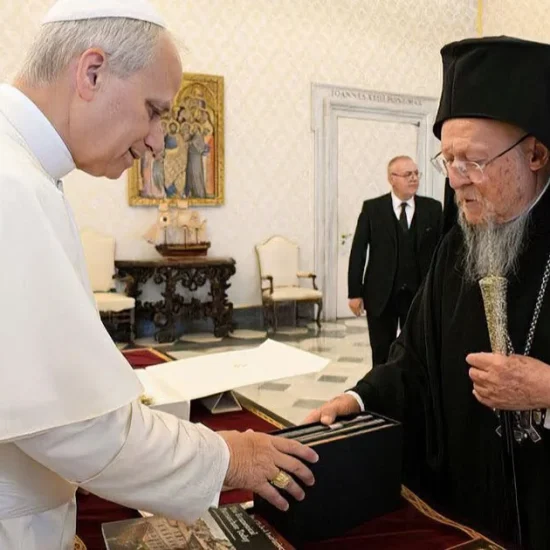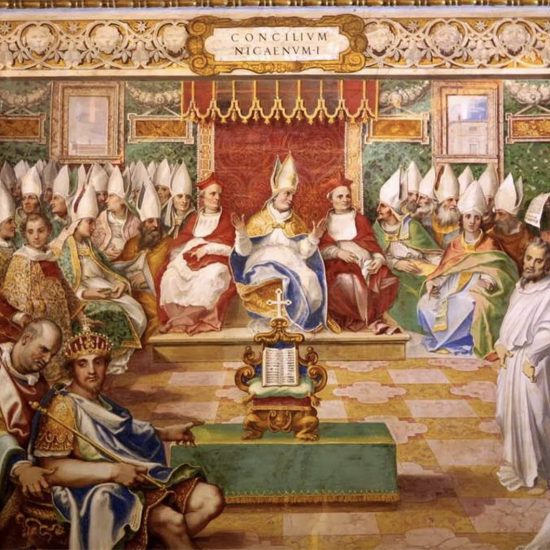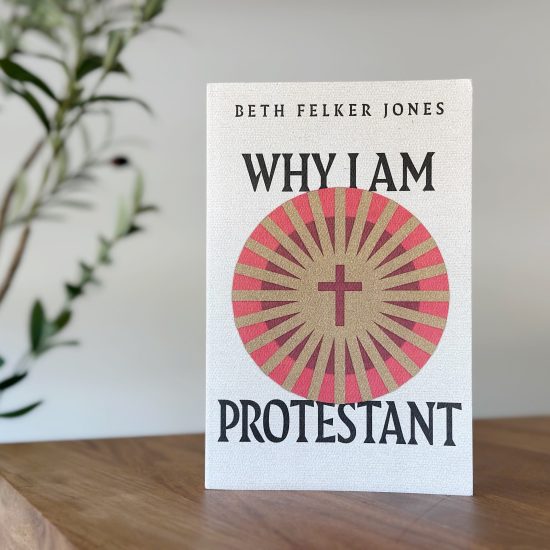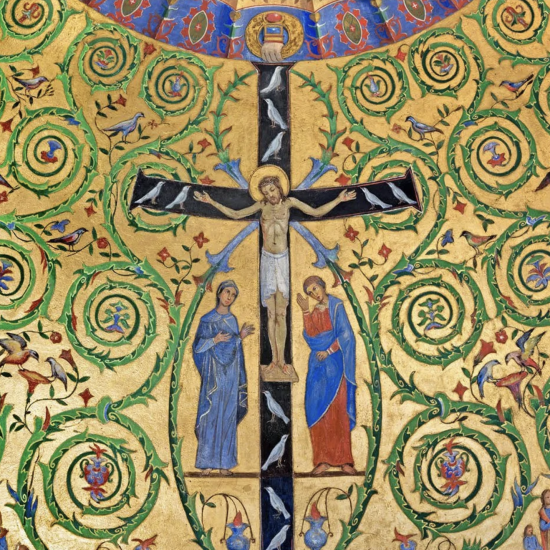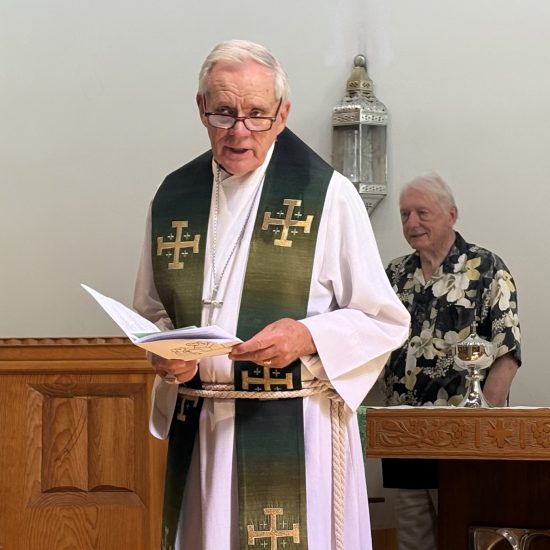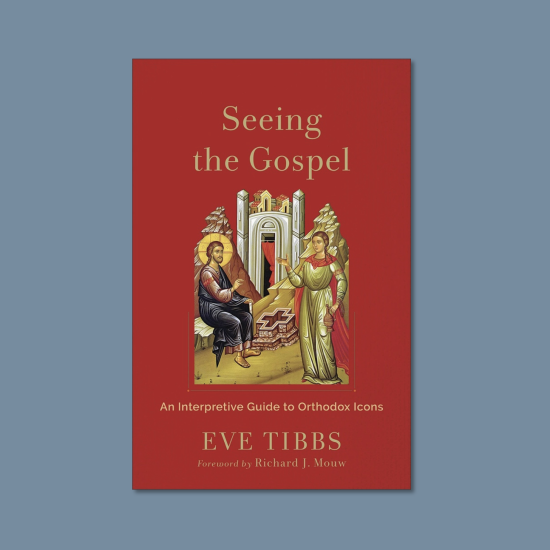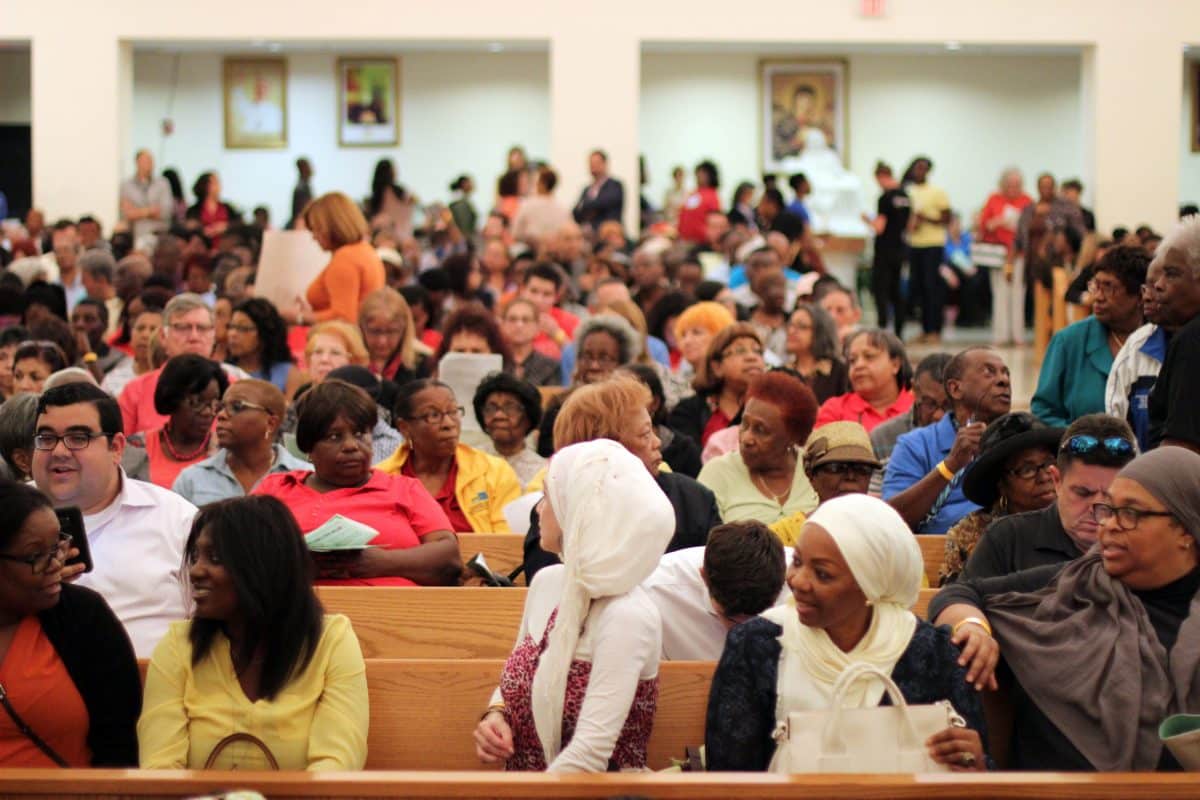
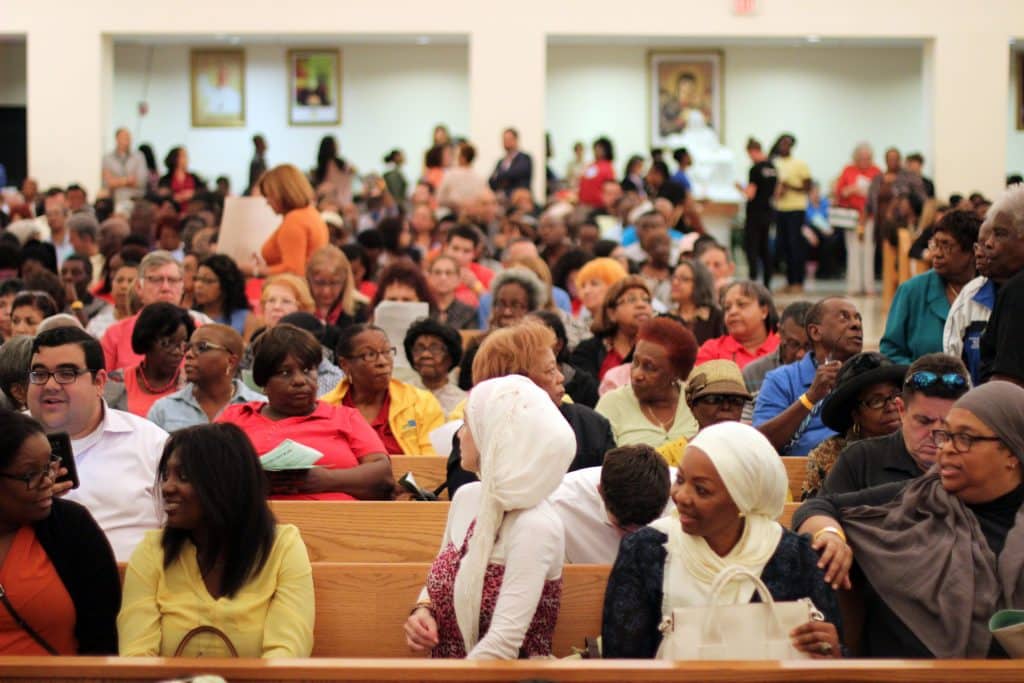
Attendees mingle before the start of the 2018 Nehemiah Action Assembly at Notre Dame d’Haiti Catholic Church in March 2018 in Miami. Photo by Micah Fae Photography
(RNS) — Rachel Prestipino knows how segregated Miami can be every day, including Sunday: “It’s not just at 11 a.m.”
But one thing all groups in Miami share, said Prestipino, lead organizer for a local faith-based organization called People Acting for Community Together, is an interest in solving local problems. “That desire, for whatever reason, goes across all these lines of difference, whether that’s faith background or race.”
PACT has helped Christians, Jews and Muslims in her community overcome their racial, ethnic and faith divides outside of their congregations.
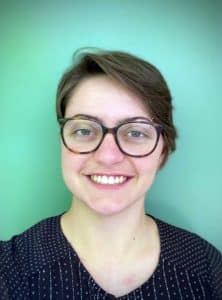
Rachel Prestipino. Photo courtesy of PACT
More than a half century after the Rev. Martin Luther King Jr. challenged the Christian church to “remove the yoke of segregation from its own body,” an estimated one-sixth of U.S. congregations have succeeded in becoming at least partly multiracial — but not without struggles. A handful of religious institutions, meanwhile, are pursuing reconciliation by pushing for reparations.
But in more than 100 U.S. cities, people of faith are choosing to come together across historic racial and religious boundaries, not at the congregational or even denominational level, but by mobilizing outside of weekly worship services to address daily problems where they live. Even if racial reconciliation is not the primary purpose of these nonpartisan coalitions, a byproduct of their work is often relationships with people who do not look — or believe — as they do.
Indiana University sociologist Brad Fulton, who directs the National Study of Community Organizing, said the number of faith-based community organizing coalitions has increased from 201 to 222 in the past five years alone. Eight percent of U.S. congregations are affiliated with a community-organizing network, such as the Direct Action Research Training Center, Faith in Action or the Industrial Areas Foundation.
A DART affiliate, PACT was founded to serve Miami-Dade County 32 years ago and today represents the 50,000 members of 40 congregations, including black, white and Latino churches, two synagogues and a mosque. DART has 22 member organizations in eight states, including nine other groups like PACT in Florida alone.
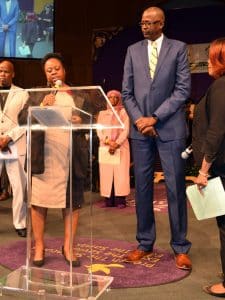
The Rev. Ana Jackson, left, questions Miami-Dade’s Deputy Mayor Maurice Kemp, right, on the county’s commitment to launching a gun violence intervention strategy at the 2019 Nehemiah Action in Miami. Photo courtesy of PACT
PACT works much like secular grass-roots community organizations: Its local activists stage rallies; research best practices around issues, like implementing restorative justice in public schools and securing affordable housing; and hold public officials accountable for addressing them, sometimes by showing up at their offices en masse to demand change.
In one current project, PACT is advocating for a community identification card for all county residents. “There are people — the undocumented, youth in foster care, the elderly — that have barriers to access (without IDs),” said Prestipino, who said ID cards can be “an equalizer, an inclusive force.”
Fulton said collaborations across race, religion and class identities not only foster relationships within coalitions but impress political leaders who see a wide range of support on the issues they work on together.
“If you can present to the politicians or show up at a meeting with a mayor with a broad-based coalition, you’re just going to be much more effective in getting the issue addressed than if you’re just one organization representing one constituency,” he said.
That gives PACT outsized influence in Miami’s intensely multicultural, but deeply segregated, context, where politics often operate by pitting its ethnic and racial communities against one another.
PACT works to combat those divisions. “We believe that we serve a God of abundance and that we can all win,” said Prestipino, who has led the organization since 2016. “In God’s city we would all have an affordable home to live in, and we don’t have to fight against each other for that.”
The group’s unity extends to which prayers and scriptures it chooses to cite. “One verse we use often is Micah 6:8,” Prestipino noted, referring to a passage in which the Hebrew biblical prophet Micah urges Israel “to do justice, love kindness, and walk humbly with God.”
“This is part of the Hebrew scriptures, the Christian tradition, and (Micah) is recognized as a prophet by Muslims as well,” said Prestipino.
As much as religion has separated the races in America, people of faith have long overcome their racial differences to fight injustice. In the civil rights era, some white Christians and Jews worked with black churches on access to the ballot, and with the Supreme Court’s decision to end certain sections of the Voting Rights Act, the cause of voter protection has become a rallying point again for white and black clergy.
The Rev. Adam R. Taylor, a black Baptist minister and executive director of the social justice organization Sojourners, said he has seen an increasing commitment to interracial organizing and interreligious engagement by churches.
“Now, some of these trends have kind of ebbed and flowed, but I think in particular we’ve seen (in) some of our work around trying to protect the right to vote and voter protection a lot of white allies wanting to come alongside black churches and engage in that work,” said Taylor, author of “Mobilizing Hope: Faith-Inspired Activism for a Post Civil Rights Generation.”
More recently, white and Asian clergy have joined their African American colleagues to counter police violence and white nationalism, he said.
One of the most well-known recent examples of multifaith coalitions was created in Charlottesville, Virginia, in response to an outburst of racial violence in 2017, after the Charlottesville City Council voted to remove a statue of Robert E. Lee and rename Lee Park.
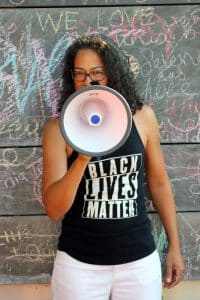
Jalane Schmidt. Photo by Locs Image Photography
During what activists dubbed the “Summer of Hate,” torch-bearing white nationalists marched on the University of Virginia campus in opposition to the council’s decision in May, the Ku Klux Klan scheduled a rally in downtown Charlottesville for July and a “Unite the Right” rally was planned for Aug. 12.
Some people of color grew increasingly frustrated as local religious leaders debated how their congregations should respond: Should clergy and congregations ignore neo-Nazis or directly confront them?
As the debate went on, said Jalane Schmidt, a University of Virginia professor and Black Lives Matter member who identifies as a queer black woman and as a Catholic, “It set up this dynamic that you can’t count on the clergy.”
This led the Rev. Brittany Caine-Conley and the Rev. Seth Wispelwey, young white ministers ordained by the United Church of Christ, to co-found Congregate Charlottesville.
Realizing that people of faith were not prepared “to demonstrate any sort of resistance to white supremacist violence,” Caine-Conley recalled, Congregate C’ville began hosting nonviolent direct-action trainings in the weeks leading up to Aug. 12.
“Many of us, across traditions, felt that there is really no greater importance than that of presence,” Caine-Conley said. Despite pleas from city officials and the police, who discouraged confronting the white supremacists, Congregate decided “we couldn’t stay away and just simply pray,” said Caine-Conley.
On the morning of Aug. 12, clergy and dozens of black and white Christians, Jews and Muslims gathered in the sanctuary of First Baptist Church, then marched from the historic black church to confront the white supremacists. The group included national religious leaders, such as the Rev. Osagyefo Sekou, Cornel West, Lisa Sharon Harper, and the Rev. Susan Frederick-Gray, president of the Unitarian Universalist Association.
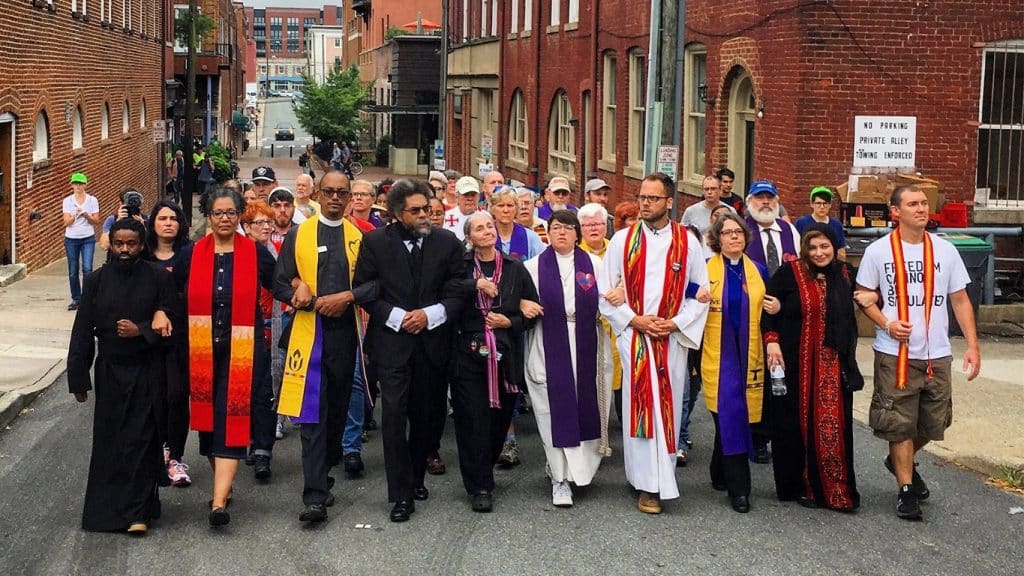
Clergy and faith leaders march to counter protest the Unite the Right rally in Charlottesville on Aug. 12, 2017. RNS photo by Jordy Yager
“It really was a turning point for a lot of folks in the United States,” Caine-Conley reflected. “It really woke folks up.” Congregate published a “national call to conscience” in the days that followed, challenging people of faith to embrace love and join the fight against white supremacy.
Charlottesville also showed, however, that faith-based organizing has yet to go beyond an activist core. The majority of those “who put their bodies and lives on the line were people of color, were people of marginalized religious identities, Jewish and Muslim,” said Caine-Conley. “It was queer folks, and it was women.”
In the days before the rally, Caine-Conley and Wispelwey had invited 1,000 clergy to Charlottesville to “confront white supremacy,” reminiscent of King’s 1965 request for clergy to come to Alabama, after white police and vigilantes brutally beat civil rights activists as they attempted to cross the Edmund Pettus Bridge in Selma.
“We really were attempting to call on white clergy, particularly white male clergy, to put their bodies on the line in ways that marginalized people are forced to every day,” said Caine-Conley.
A thousand clergy did not come. Even most Charlottesville clergy stayed home.
If King’s challenge was then to a largely Christian, churchgoing nation, today the effort at desegregation is equally aimed at including members of other faiths and immigrant populations of color.
In 2017, Imam Mohamed Omar, executive director of Dar Al-Farooq Islamic Center in Bloomington, Minnesota, decided it was no longer prudent to remain isolated after members of an Illinois militia threw a pipe bomb into his mosque. Joining forces with other imams in the area, Omar, a refugee from war-torn Somalia, approached ISAIAH, a 20-year-old mostly white and Christian community organizing coalition based in St. Paul.
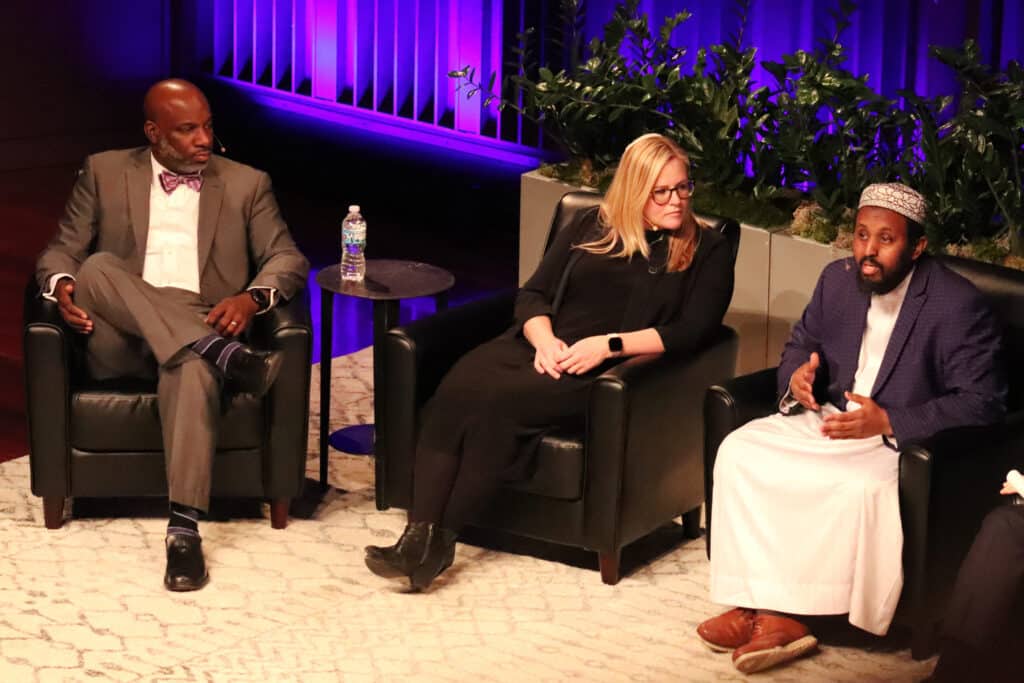
Imam Mohamed Omar, right, speaks during the Faith, Race, and Politics conference, Jan. 13, 2020, in Cincinnati. Fellow panelists Rev. Mark Tyler, left, and Rabbi Miriam Terlinchamp listen. RNS photo by Adelle M. Banks
Through a week-long training with ISAIAH, Omar discovered the struggles of other people of faith, and other ISAIAH trainees in turn saw the pain his congregation had endured. “When some of us suffer, all of us will suffer,” Omar told the Faith, Race, and Politics conference in Cincinnati in January. In the wake of the bombing, ISAIAH members and others in the community developed a political response to Islamophobia that included a report on anti-Muslim propaganda in their state.
ISAIAH’s executive director, Doran Schrantz, said the group, which has engaged black churches since its start and has included a Latinx Coalition for six years, has grown from a predominantly Christian to a multifaith coalition, with a Muslim cohort of some 20 mosques. Black barbershops and Somali child care centers are now among its institutional members from cities and rural areas across the state.
She said one of the goals of the coalition is to help whites and nonwhites appreciate the benefits of “shared power” from their broader relationships.
“A lot of the work that we do with white people and white people of faith is, this is about you, not you helping other people,” said Schrantz, a white laywoman who is a member of the Evangelical Lutheran Church in America. “You’re not doing charity with the Muslims. And you don’t get to act that way with them. The question is, what’s at stake for you in building a multiracial democracy that has economic justice and racial justice in it?”
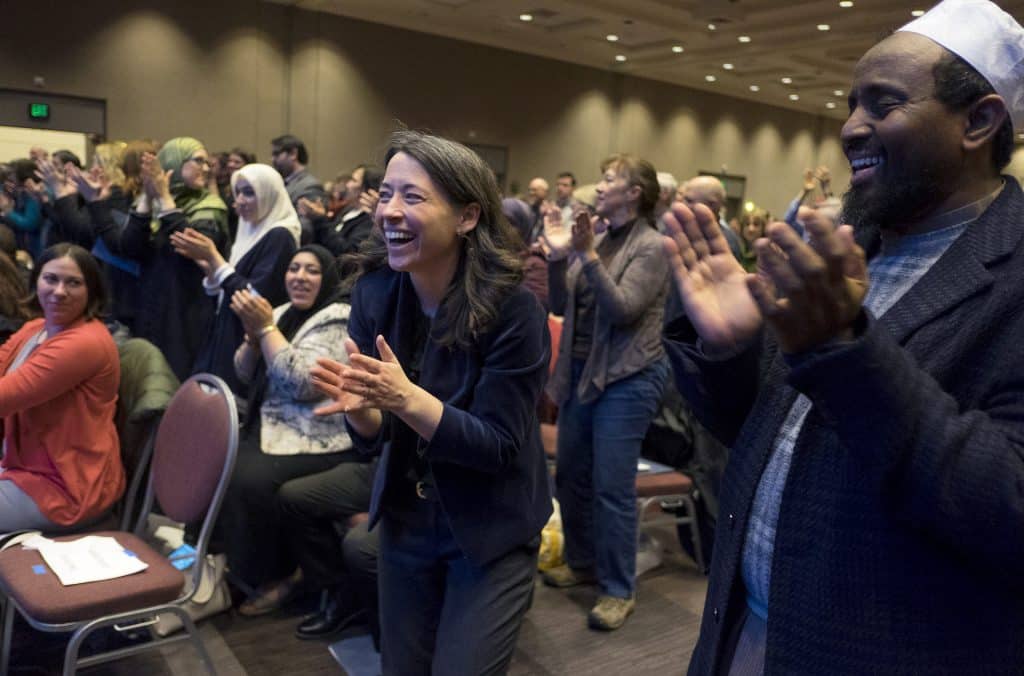
ISAIAH executive director Doran Schrantz, center, and Imam Mohamed Omar, right, applaud during ISAIAH’s Claiming Our Voices 2019 event, Saturday, Jan. 19, 2019, at the Minneapolis Convention Center. Photo courtesy of ISAIAH
ISAIAH, a Faith in Action affiliate, now connects 250,000 people in Minnesota, 60% of whom are white and 40% of whom are people of color.
“Our main focus is organizing the not already-woke,” Schrantz said, noting that they are trying to help people in the pews — or on prayer rugs — understand what local issues matter to them. “You’re actually getting people engaged through the lens of their own experience as opposed to what is happening on MSNBC versus Fox News.”
ISAIAH recently won a significant victory: A state sentencing commission approved in January a five-year maximum probation for most felonies.
Omar, whose community is awaiting the trial of the alleged ringleader of the attack on his mosque, said working with ISAIAH has brought together people who might be uncomfortable with the singing or praying of an interfaith service on Martin Luther King Jr. Day. They could more easily come together on championing the five-year probation limit.
“That is something I can literally bring my people and say this is what’s happening,” said Omar, in an interview. “I’m not taking you to an interfaith dinner. I’m taking you to work that can change your life and my life and our neighbor’s life. And that’s resonating with a lot of people.”
This story is one in a series by Religion News Service about the future of segregation and integration in American religion, produced in partnership with Sacred Writes, a project that helps scholars share their research with a broader audience.

